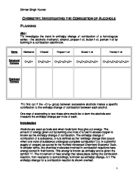A longer molecule takes more energy to break its bonds; in this case Pentanol takes the most energy. A smaller molecule like ethanol requires less energy to do so. I can come to predict that the longer the molecular structure in the alcohol the more energy it will take to remove the bonds.
Factors that will affect the experiment
- The change in temperature allowed.
- Whether the apparatus is insulated.
- The amount of water used.
- The amount of alcohol used.
- The amount of time allowed.
- The distance between the flame and the container.
- Weigh the alcohol burner with the lid on.
Fair Test
In order to make it a fair test I will be keeping all factors the same, except one variant, which will be the amount of alcohol, used.
Equipment
- Water
- Alcohols
- Clamp Stand
- Stopwatch
- Required alcohol and burner
- Copper Container
- Measuring cylinder
- Thermometer
- Scales
- Insulating polythene
Diagram
Method
- Set up the equipment in the specified way.
- Weigh the alcohol and burner.
- Light the wick of the burner and begin timing.
- Extinguish the flame after 60 seconds.
- Measure the temperature.
- Re-weigh the alcohol and burner.
- Calculate the difference.
- Record the results.
- Repeat these stages 2 times for each different alcohol. This will produce an average result.
Results
Ethanol
Propanol
Butanol
Pentanol
Collected Results
Analysis
The energy is given out when forming the bonds between the new water and carbon dioxide molecules.
First of all I will calculate the amount of energy evolved. I will achieve this by using this simple formula.
Energy evolved = Mass x Temp. Difference x Specific Heat Capacity Water
To find out how much energy is produced when the fuel is burnt. We need the formula: ~
Energy per gram of fuel = Energy evolved x Mass of fuel burnt
To find out how much energy is produced per mole you have to use this formula.
Energy per mole = Energy per gram x Formula mass
Calculations of heat transfer
Ethanol
Mass = 100g
Temp change = 10ºC
Specific heat capacity = 4.2j
Heat transfer = 100 x 10 x 4.2
= 4200J
Propanol
Mass = 100g
Temp change = 6.5ºC
Specific heat capacity = 4.2j
Heat transfer = 100 x 6.5 x 4.2
= 2730J
Butanol
Mass = 100 g
Temp change = 13.5ºC
Specific heat capacity = 4.2j
Heat transfer = 100 x 13.5 x 4.2
= 5670J
Pentanol
Mass = 100 g
Temp change = 9.5ºC
Specific heat capacity = 4.2j
Heat transfer = 100 x 9.5 x 4.2
= 3990J
I have now got all the evidence I need to find the energy transferred by 1 gram of fuel.
Energy transferred=Energy transferred
Mass of fuel by 1 gram of fuel
Evaluation
This experiment shows that my prediction was almost correct. Somewhere in the experiment I must have slipped up because my results differ slightly to what I had hoped would happen.
These two results didn't seem to fit with the others. Ethanol’s transfer rate should have been higher than that of the Butanol.
Overall I think my experiment was fairly accurate. However, I could have done certain things to make my results more accurate.
Improving accuracy
- I would have used a more accurate instrument to measure the temperature with, as this would have given me much better and more accurate results.
- Also I would have used better equipment to reduce the heat loss in the experiment.
Conclusion
I have found that my prediction was correct. In my prediction I said that the amount of heat produced per gram would increase as the number of chemical bonds in an alcohol increases. This statement turned out to be true.
So, I conclude that the most efficient alcohol out of the ones that I had investigated was Pentanol, and the least efficient was Ethanol.







